Species/Notes of Interest to
Aquarists:
This genus is notable for their beauty as juveniles, turning to drab
adults.
| Neoglyphidodon carlsoni (Allen 1975),
Carlson's Damsel. Known only from Fiji presently. To four
inches in length. Pictured is a somber adult where (Bruce) Carlson
reigns, the Waikiki Aquarium, Hawai'i. Oh, now retired, sometimes in
O'ahu, otherwise out traveling. |
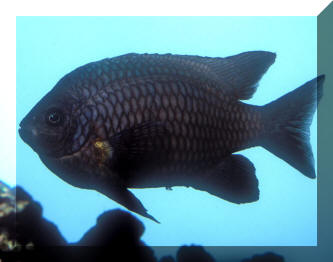
|
| Neoglyphidodon crossi Allen 1991, Cross'
Damsel. Indo-Malayan Archipelago: known only from Sulawesi and the
Molucca Islands. To four inches. Aquarium and Raja Ampat
images. |
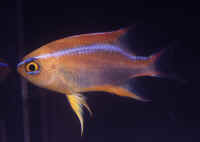 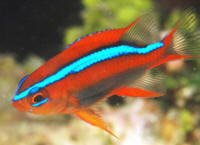
|
| Neoglyphidodon melas (Cuvier 1830), the
Black Damsel. Indo-west Pacific, Red Sea, eastern Africa to
Vanuatu. To five inches total length. An all black beauty as an
adult, resembling the Black Dwarf Angel, Centropyge nox in
profile. Juvenile in Australia's GBR and adult in
Malaysia pictured. |
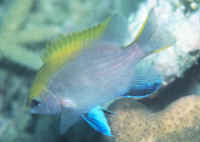 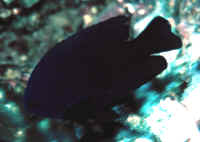
|
Bigger PIX:
The images in this table are linked
to large (desktop size) copies. Click on "framed" images
to go to the larger size. |
|
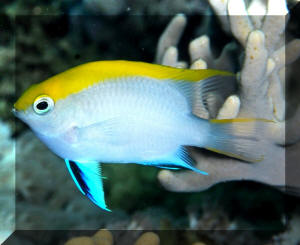
|
| Neoglyphidodon nigroris (Cuvier 1830),
Behn's Damsel. Western Pacific and eastern Indian Ocean. To
three and a half inches in length. The bright yellow and two
horizontal black band juveniles are used quite often in the trade.
At right a juv. in captivity. Below: juvenile off Heron Island,
Australia. and subadult in Bunaken/Sulawesi/Indonesia. |
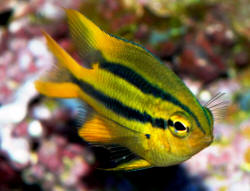 |
Bigger PIX:
The images in this table are linked
to large (desktop size) copies. Click on "framed" images
to go to the larger size. |
|
%20MD.JPG)
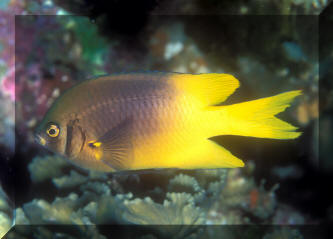
|
| Neoglyphidodon oxyodon (Bleeker 1858), the
most commonly named "Jewel Damsel" in the aquarium
interest is called the Javanese Damsel to science. Indo-Australian
Archipelago. To six inches total length, and a tough customer
nearing larger size. |
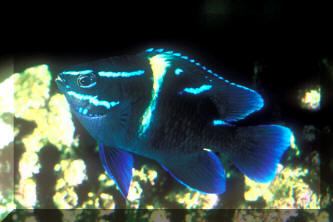
|
| Neoglyphidodon polyacanthus (Ogilby 1889),
the Multispine Damselfish. To five and a half inches in length. The
smallest juveniles of this species are good-looking all yellow with
a bold blue line and ocellus. Pictured are a sub-adult and adult in
Fiji. |
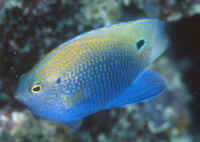 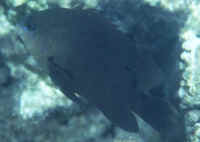
|
Bigger PIX:
The images in this table are linked
to large (desktop size) copies. Click on "framed" images
to go to the larger size. |
|
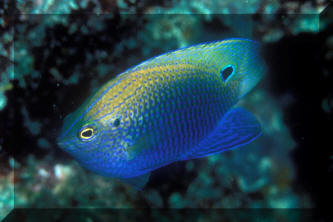
|
| Neoglyphidodon thoracotaeniatus (Fowler
& Bean 1928), the Banded Damsel. Western Central Pacific. To a
bit over three inches in length. This one in Pulau Redang,
Malaysia. |
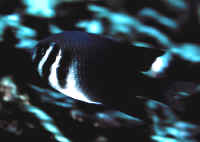
|
Bigger PIX:
The images in this table are linked
to large (desktop size) copies. Click on "framed" images
to go to the larger size. |
%20MD.JPG) |
Bibliography/Further Reading:
Allen, Gerald R. 1975. Damselfishes of the South Seas.
TFH Publications, Neptune City, N.J.
Allen, Gerald R. 1976. How many sergeant majors? Marine
Aquarist 7(6):76.
Allen, Gerald R. 1991. Damselfishes of the World.
Aquarium Systems, Mentor, Ohio.
American Society of Ichthyologists and Herpetologists,
1978. The Biology of the Damselfishes a symposium held during the
56th annual meeting of the ASIH. Rosentiel School
of Mar. & Atm. Sci. U. of Miami, 1980, 145-328.
Bunn, D., 1987. Spawning the Dusky Damsel. Aquarist
Pondkpr. 52(1):41
Fenner, Bob & Cindi Camp, 1991. Damselfishes,
saltwater bread and butter. FAMA 10/91.
Fenner, Robert. 1998. The Conscientious Marine Aquarist.
Microcosm, VT. 432pp.
Fenner, Robert. 1999. The indomitable damsels- Family
Pomacentridae. TFH 1/99.
Flood, A. Colin. 1992. Thos darling damsels. TFH
8/92.
Gronell, A.M., 1984. Look-alike damsels. TFH 32(8)
48-53.
Pearson, Scott. 1993. On photographing the feisty
damsels. Sea Frontiers May/June 93.
Thresher, R.E., P.L. Colin & Lori J. Bell. 1989.
Planktonic duration, distribution and population structure of western
and central Pacific damselfishes (Pomacentridae). Copeia 1989(2), pp.
420-434.

